
Alder is the common name of a genus of flowering plants, Alnus, belonging to the birch family Betulaceae. The genus comprises about 35 species of monoecious trees and shrubs, a few reaching a large size, distributed throughout the north temperate zone with a few species extending into Central America, as well as the northern and southern Andes.

Pinus nigra, the Austrian pine or black pine, is a moderately variable species of pine, occurring across southern Mediterranean Europe from the Iberian Peninsula to the eastern Mediterranean, on the Anatolian peninsula of Turkey on Corsica and Cyprus as well as Crimea and in the high mountains of Northwest Africa.
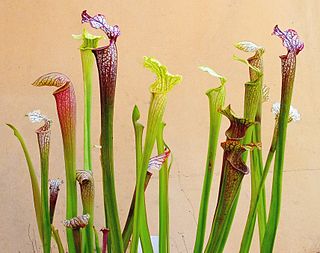
Sarracenia is a genus comprising 8 to 11 species of North American pitcher plants, commonly called trumpet pitchers. The genus belongs to the family Sarraceniaceae, which also contain the closely allied genera Darlingtonia and Heliamphora.
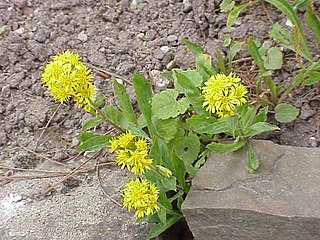
Solidago virgaurea, the European goldenrod or woundwort, is an herbaceous perennial plant of the family Asteraceae. It is widespread across most of Europe as well as North Africa and northern, central, and southwestern Asia. It is grown as a garden flower with many different cultivars. It flowers profusely in late summer.
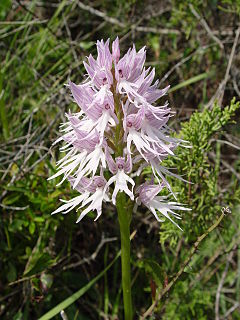
Orchis is a genus in the orchid family (Orchidaceae), occurring mainly in Europe and Northwest Africa, and ranging as far as Tibet, Mongolia, and Xinjiang. The name is from the Ancient Greek ὄρχις orchis, meaning "testicle", from the appearance of the paired subterranean tuberoids.
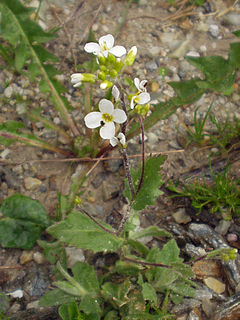
Arabis alpina, the Alpine rock-cress, is a flowering plant in the family Brassicaceae, native to mountainous areas of Europe, North and East Africa, Central and Eastern Asia and parts of North America. In the British Isles, it is only known to occur in a few locations in the Cuillin Ridge of the Isle of Skye. It inhabits damp gravels and screes, often over limestone.

Sarracenia rubra, also known as the sweet pitcherplant, or purple pitcherplant, is a carnivorous plant in the genus Sarracenia. Like all Sarracenia, it is native to the New World. Its range extends from southern Mississippi, through southern Alabama, the Florida panhandle and Georgia, to the coastal plains of Virginia and South Carolina.

Hirkan National Park — is a national park of Azerbaijan. It was established in an area in Lankaran Rayon and Astara Rayon administrative districts on February 9, 2004 on the basis of the former "Hirkan State Reserve" which it superseded, on a surface area of 29,760 hectares (297.6 km2). It was enlarged by presidential decree on April 23, 2008 from 29,760 hectares (297.6 km2) to 40,358 hectares (403.58 km2).
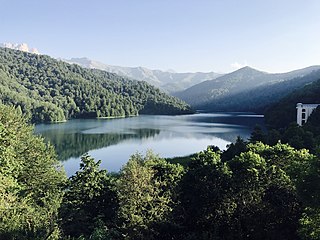
Göygöl National Park — is a national park of Azerbaijan. It was established in an area in Goygol Rayon administrative district on April 1, 2008 on the basis of the former "Goy Gol State Reserve" that was established in 1925 and which it superseded, on a surface area of 12,755 hectares (127.55 km2). It was enlarged from 6,739 hectares (67.39 km2) of the former state reserve to its current surface area as a national park.

Shahdag National Park — is a national park of Azerbaijan. It was established on an area of 115,900 hectares (1,159 km2) in the Quba Rayon, Qusar Rayon, İsmayıllı Rayon, Qəbələ Rayon, Oğuz Rayon and Şamaxı Rayon administrative districts on December 8, 2006. It was enlarged by presidential decree on July 8, 2010 from 115,900 hectares (1,159 km2) to 130,508.1 hectares (1,305.081 km2).

Himantoglossum is a genus of orchids native to the Canary Islands, Europe, southwest Asia and northern Africa. Its members generally have a labellum which is divided into three parts, of which the middle part is the longest.

Paeonia officinalis, the common peony, or garden peony, is a species of flowering plant in the family Paeoniaceae, native to mainly mountainous areas of Southern Europe and introduced in Central and Western Europe and North America.

Dactylorhiza romana, the Roman dactylorhiza, is a species of orchid. It is native to the Mediterranean Region of southern Europe and northern Africa, the range extending eastward to Iran and Turkmenistan.

Lilium monadelphum is a bulbous plant native to Crimea and to North and South Caucasus.

Paeonia daurica is a perennial herbaceous plant belonging to the peony family. It has slender carrot-shaped roots, leaves mostly consisting of nine leaflets, with one flower per stem. The flower is subtended by none to two leafy bracts, and has two or three sepals, five to eight petals, and many stamens. The subspecies vary in the colour of the petals, the size and shape of the leaflets, and the hairiness of the leaflets and the carpels. Paeonia daurica can be found from the Balkans to Iran, and the Crimea to Lebanon, with the centre of its distribution in the Caucasus. It is also cultivated as an ornamental.

Crocus speciosus, with common name Bieberstein's crocus, is a species of flowering plant in the genus Crocus of the family Iridaceae. The plant is native to northern and central Turkey, the Caucasus, northern Iran, Crimea.
- Crocus speciosus subsp. ilgazensisB.Mathew - Turkey
- Crocus speciosus subsp. speciosus - Turkey, Iran, Caucasus, Crimea
- Crocus speciosus subsp. xantholaimosB.Mathew - Sinop Province in Turkey

Arabis caucasica is a species of flowering plant in the mustard family (Brassicaceae) known by the common names garden arabis, mountain rock cress or Caucasian rockcress. It is native to south eastern Europe and the Mediterranean. It is also present in the Madeira Archipelago.

The total forest area of Azerbaijan is 1,021,880 ha or 11.8% of the country's area. The forest biomes consist of temperate deciduous forests, temperate broadleaf and mixed forests, temperate coniferous forests and riparian forests. Specialists estimate that in the 8th-9th centuries the forest cover was around 30-35%, most of it situated in mountainous areas.
Professor Christopher Donald Pigott is a British botanist and was the fourth Director, Cambridge University Botanic Garden (1984–1995), succeeding Max Walters.
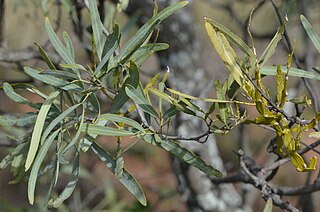
Korthalsella rubra is a flowering plant in the Santalaceae (sandalwood) family, formerly placed in the Viscaceae.



















